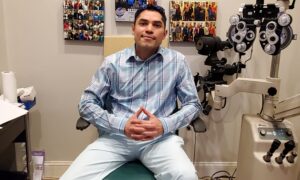By Cheryl G. Murphy, OD

Sept. 25, 2019
Over the past few years I have seen many articles pop up in my newsfeed about how getting outside and exercising is good for us.
Some articles say that people who live in green spaces (surrounded by many trees) live longer because their blood pressure tends to be lower and they have less incidence of cancer.
Others say that time outdoors can reduce myopia progression by allowing us to look at objects in the far distance and perhaps inadvertently giving our eyes (and necks) a break from staring at our phones. We also know that simple steps toward more physical activity can improve a person’s overall vascular health, which is crucial for those managing diabetes and high blood pressure.
With so much evidence emerging of the benefits of exercise outdoors, I have started incorporating discussion of it in my treatment plans with patients.
Educating Patients on Value of Exercise & Outdoors
I have started initiating conversations about exercise with patients, and have started to provide them with specific, customized suggestions on how they can increase their physical activity.
Other Articles to Explore
For example, I had a female patient present with arterial tortuosity. I asked her if she had been told she had this appearance to the retinal arteries before (thinking it had been present since birth.) She had not. This really didn’t tell me much since arterial tortuosity may be considered a variation of normal in absence of other arterial changes, and her previous eye doctors may have seen it, noted it and just never spoke to her about it.
I thought it was a good idea to educate her on it, letting her know it may be normal or it may be an early sign of vascular problems such as diabetes or uncontrolled high blood pressure. She opened up to me that she had been going through a rough, stressful year and that her doctor had been watching her blood pressure closely because at times it had been spiking dramatically. She confided in me that she had been searching for a way to de-stress physically and mentally.
It was then that I shared with her my recent experience trying out a free, beginner “beach yoga” program at a local state park, and I suggested she try it too. She was thrilled, saying she was thinking of trying yoga anyway. I went one step further and printed out all of the information on times, location and details from the program’s web site for her. She thanked me profusely and then at the end of the exam she said, “You really care.”
Those words struck me. As an eyecare professional, “care” is in my title. It is the reason why many of us became doctors in the first place, but I knew what she meant. I broke out of the doctor-patient “routine” and “the script” that we all fall into using. I listened and “prescribed” what I thought may help the patient beyond just me recording “monitor every 12 months” in my assessment and plan.
Encourage Small Steps Toward Overall Wellness
I’m not saying we should suggest patients start trying Crossfit or move to the woods, but simple, low-impact exercise and spending some time outdoors on the weekend in a green space may be a helpful suggestion.
In New York, where I live and practice, residents can buy an Empire Pass, which gives them unlimited access to state parks for one year for $80. Seniors over age 62 are eligible for the Golden Park Pass, which is free and gives them unlimited access on weekdays at no charge. It may be worthwhile for eyecare professionals to familiarize themselves with similar state and local programs in order to make proper suggestions on where patients can go and what they can do.
Follow your local, state and national parks on social media so that you see the different programs and events they offer. Arboretums and historical sites also sometimes offer guide-led “forest bathing” walks or pop-up yoga events, as well as historical walking tours of the grounds or gardens. Even a patient taking a walk around their own block is a start, or building a little outdoor space on their patio or deck with a comfortable chair where they can feel connected with nature and be device-free.
It’s time we eyecare professionals step beyond our scripts and routine conversations about prescribed glasses, contacts and medications and come up with ideas on how we can get patients to be more active, less stressed and out there enjoying green spaces more. We can make a difference. Let’s put the “I care” back into “eyecare.”
Have you prescribed time outdoors to a patient and did you hear back from them to hear how it benefited them? What have you done to encourage patients get more physical activity aside from saying “exercise more?” Do you think optometrists and ophthalmologists should start prescribing green space time to help slow myopia progression in kids and others? How comfortable would you feel suggesting someone at risk or already diagnosed with hypertension or diabetes get a state park pass or begin walking outdoors more?
 Cheryl G. Murphy, OD, practices in Glen Cove, Syosset and Lake Ronkonkoma, N.Y. You can like her on Facebook or follow her on Twitter @murphyod. To contact her: murphyc2020@gmail.com.
Cheryl G. Murphy, OD, practices in Glen Cove, Syosset and Lake Ronkonkoma, N.Y. You can like her on Facebook or follow her on Twitter @murphyod. To contact her: murphyc2020@gmail.com.























